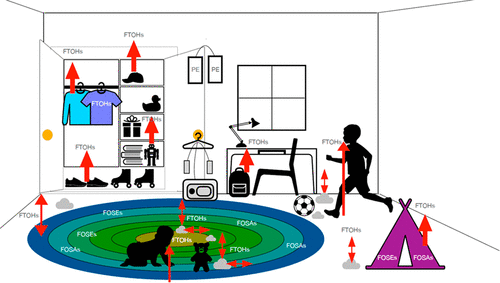当前位置:
X-MOL 学术
›
Environ. Sci. Technol. Lett.
›
论文详情
Our official English website, www.x-mol.net, welcomes your
feedback! (Note: you will need to create a separate account there.)
The Air That We Breathe: Neutral and Volatile PFAS in Indoor Air
Environmental Science & Technology Letters ( IF 8.9 ) Pub Date : 2021-08-31 , DOI: 10.1021/acs.estlett.1c00481 Maya E Morales-McDevitt 1 , Jitka Becanova 1 , Arlene Blum 2 , Thomas A Bruton 2 , Simon Vojta 1 , Melissa Woodward 1 , Rainer Lohmann 1
Environmental Science & Technology Letters ( IF 8.9 ) Pub Date : 2021-08-31 , DOI: 10.1021/acs.estlett.1c00481 Maya E Morales-McDevitt 1 , Jitka Becanova 1 , Arlene Blum 2 , Thomas A Bruton 2 , Simon Vojta 1 , Melissa Woodward 1 , Rainer Lohmann 1
Affiliation

|
Sources of exposure to per- and polyfluorinated alkyl substances (PFAS) include food, water, and, given that humans spend typically 90% of their time indoors, air and dust. Quantifying PFAS that are prevalent indoors, such as neutral, volatile PFAS, and estimating their exposure risk to humans are thus important. To accurately measure these compounds indoors, polyethylene (PE) sheets were employed and validated as passive detection tools and analyzed by gas chromatography–mass spectrometry. Air concentrations were compared to dust and carpet concentrations reported elsewhere. Partitioning between PE sheets of different thicknesses suggested that interactions of the PEs with the compounds are occurring by absorption. Volatile PFAS, specifically fluorotelomer alcohols (FTOHs), were ubiquitous in indoor environments. For example, in carpeted Californian kindergarten classrooms, 6:2 FTOH dominated with concentrations ranging from 9 to 600 ng m–3, followed by 8:2 FTOH. Concentrations of volatile PFAS from air, carpet, and dust were closely related to each other, indicating that carpets and dust are major sources of FTOHs in air. Nonetheless, air posed the largest exposure risk of FTOHs and biotransformed perfluorinated alkyl acids (PFAA) in young children. This research highlights inhalation of indoor air as an important exposure pathway and the need for further reduction of precursors to PFAA.
中文翻译:

我们呼吸的空气:室内空气中的中性和挥发性 PFAS
暴露于全氟和多氟烷基物质 (PFAS) 的来源包括食物、水,并且鉴于人类通常将 90% 的时间花在室内,因此还包括空气和灰尘。因此,量化室内普遍存在的 PFAS,例如中性、挥发性 PFAS,并估计它们对人类的暴露风险非常重要。为了在室内准确测量这些化合物,聚乙烯 (PE) 片材被用作被动检测工具并经过验证,并通过气相色谱-质谱法进行分析。空气浓度与其他地方报告的灰尘和地毯浓度进行了比较。不同厚度的 PE 片材之间的分配表明 PE 与化合物的相互作用是通过吸收发生的。挥发性 PFAS,特别是含氟调聚物醇 (FTOH),在室内环境中无处不在。例如,–3,然后是 8:2 FTOH。空气、地毯和灰尘中挥发性PFAS的浓度相互密切相关,表明地毯和灰尘是空气中FTOHs的主要来源。尽管如此,空气对幼儿的 FTOH 和生物转化的全氟烷基酸 (PFAA) 的暴露风险最大。这项研究强调吸入室内空气是一种重要的暴露途径,需要进一步减少 PFAA 的前体。
更新日期:2021-10-12
中文翻译:

我们呼吸的空气:室内空气中的中性和挥发性 PFAS
暴露于全氟和多氟烷基物质 (PFAS) 的来源包括食物、水,并且鉴于人类通常将 90% 的时间花在室内,因此还包括空气和灰尘。因此,量化室内普遍存在的 PFAS,例如中性、挥发性 PFAS,并估计它们对人类的暴露风险非常重要。为了在室内准确测量这些化合物,聚乙烯 (PE) 片材被用作被动检测工具并经过验证,并通过气相色谱-质谱法进行分析。空气浓度与其他地方报告的灰尘和地毯浓度进行了比较。不同厚度的 PE 片材之间的分配表明 PE 与化合物的相互作用是通过吸收发生的。挥发性 PFAS,特别是含氟调聚物醇 (FTOH),在室内环境中无处不在。例如,–3,然后是 8:2 FTOH。空气、地毯和灰尘中挥发性PFAS的浓度相互密切相关,表明地毯和灰尘是空气中FTOHs的主要来源。尽管如此,空气对幼儿的 FTOH 和生物转化的全氟烷基酸 (PFAA) 的暴露风险最大。这项研究强调吸入室内空气是一种重要的暴露途径,需要进一步减少 PFAA 的前体。











































 京公网安备 11010802027423号
京公网安备 11010802027423号